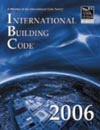|
SECTION
713 FIRE-RESISTANT JOINT SYSTEMS
713.1
General. Joints installed in or between fire-resistance-rated
walls, floor or floor/ceiling assemblies and roofs or roof/ceiling
assemblies shall be protected by an approved fire-resistant
joint system designed to resist the passage of fire for a
time period not less than the required fire-resistance rating
of the wall, floor or roof in or between which it is installed.
Fire-resistant joint systems shall be tested in accordance
with Section 713.3. The void created at the intersection of
a floor/ceiling assembly and an exterior curtain wall assembly
shall be protected in accordance with Section 713.4.
Exception: Fire-resistant joint systems shall not be required
for joints in all of the following locations:
1.Floors within a single dwelling
unit.
2.Floors where the joint is protected by a shaft enclosure
in accordance with Section 707.
3.Floors within atriums where the space adjacent to the
atrium is included in the volume of the atrium for smoke
control purposes.
4.Floors within malls.
5.Floors within open parking
structures.
6.Mezzanine floors.
7.Walls that are permitted to have unprotected openings.
8.Roofs where openings are
permitted.
9.Control joints not exceeding a maximum width of 0.625
inch (15.9 mm) and tested in accordance with ASTME 119.
713.2
Installation. Fire-resistant joint systems shall be securely
installed in or on the joint for its entire length so as not
to dislodge, loosen or otherwise impair its ability to accommodate
expected building movements and to resist the passage of fire
and hot gases.
713.3
Fire test criteria. Fire-resistant joint systems shall
be tested in accordance with the requirements of either ASTM
E 1966 or UL 2079. Nonsymmetrical wall joint systems shall
be tested with both faces exposed to the furnace, and the
assigned fire-resistance rating shall be the shortest duration
obtained from the two tests. When evidence is furnished to
show that the wall was tested with the least fire-resistant
side exposed to the furnace, subject to acceptance of the
building official, the wall need not be subjected to tests
from the opposite side.
Exception: For exterior walls with a horizontal fire separation
distance greater than 5 feet (1524 mm), the joint system shall
be required to be tested for interior fire exposure only.
713.4
Exterior curtain wall/floor intersection. Where fire resistance-rated
floor or floor/ceiling assemblies are required, voids created
at the intersection of the exterior curtain wall assemblies
and such floor assemblies shall be sealed with an approved
material or system to prevent the interior spread of fire.
Such material or systems shall be securely installed and capable
of preventing the passage of flame and hot gases sufficient
to ignite cotton waste where subjected either to ASTM E 119
time-temperature fire conditions under a minimum positive
pressure differential of 0.01 inch (0.254 mm) of water column
(2.5 Pa) or installed as tested in accordance with ASTM E
2307 for the time period at least equal to the fire-resistance
rating of the floor assembly. Height and fire-resistance
requirements for curtain wall spandrels shall comply with
Section 704.9.
713.5
Spandrel wall. Height and fire-resistance requirements
for curtain wall spandrels shall comply with Section
704.9. Where Section 704.9 does
not require a fire-resistance-rated spandrel wall, the requirements
of Section 713.4 shall still apply to the intersection between
the spandrel wall and the floor.
713.6
Fire-resistant joint systems in smoke barriers. Fire-resistant
joint systems in smoke barriers shall be tested in accordance
with the requirements of UL 2079 for air leakage. The air
leakage rate of the joint shall not exceed 5 cfm per lineal
foot (0.00775 m3/s1m) of joint at 0.30
inch (7.47 Pa) of water for both the ambient temperature and
elevated temperature tests.
|

